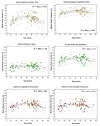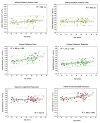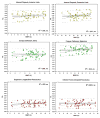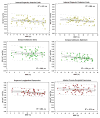Adult age differences in subcortical myelin content are consistent with protracted myelination and unrelated to diffusion tensor imaging indices
- PMID: 27561713
- PMCID: PMC5124541
- DOI: 10.1016/j.neuroimage.2016.08.047
Adult age differences in subcortical myelin content are consistent with protracted myelination and unrelated to diffusion tensor imaging indices
Abstract
Post mortem studies suggest protracted myelination of subcortical white matter into the middle age followed by gradual decline in the late adulthood. To date, however, establishing the proposed inverted-U pattern of age-myelin association proved difficult, as the most common method of investigating white matter, diffusion tensor imaging (DTI), usually reveals only linear associations between DTI indices and age among healthy adults. Here we use a novel method of estimating Myelin Water Fraction (MWF) based on modeling the short spin-spin (T2) relaxation component from multi-echo T2 relaxation imaging data and assess subcortical myelin content within six white matter tracts in a sample of healthy adults (N=61, age 18-84 years). Myelin content evidenced a quadratic relationship with age, in accord with the pattern observed postmortem studies. In contrast, DTI-derived indices that are frequently cited as proxies for myelination, fractional anisotropy (FA) and radial diffusivity (RD), exhibited linear or null relationships with age. Furthermore, the magnitude of age differences in MWF varied across the white matter tracts. Myelin content estimated by MWF was unrelated to FA and correlated with RD only in the splenium. These findings are consistent with the notion that myelination continues throughout the young adulthood into the middle age. The results demonstrate that single-tensor DTI cannot serve as a source of specific proxies for myelination of white matter tracts.
Keywords: Aging; Brain; Fractional Anisotropy; Multi-exponential T(2) relaxation; White Matter.
Copyright © 2016 Elsevier Inc. All rights reserved.
Conflict of interest statement
statement The authors of this publication have no conflicts to disclose.
Figures








References
-
- Baltes PB, Nesselroade JR. History and rationale of longitudinal research. In: Nesselroade JR, Baltes PB, editors. Longitudinal research in the study of behavior and development. New York: Academic Press; 1979. pp. 1–39.
-
- Bartzokis G, Beckson M, Po HLu, Nuechterlein KH, Edwards N, Mintz J. Age-related changes in frontal and temporal lobe volumes in men: A magnetic resonance imaging study. JAMA Psychiatry. 2001;58(5):461–465. - PubMed
-
- Basser PJ, Mattiello J, LeBihan D. Estimation of the effective self-diffusion tensor from the NMR spin echo. Journal of Magnetic Resonance, Series B. 1994;103:247–254. - PubMed
MeSH terms
Grants and funding
LinkOut - more resources
Full Text Sources
Other Literature Sources
Miscellaneous

